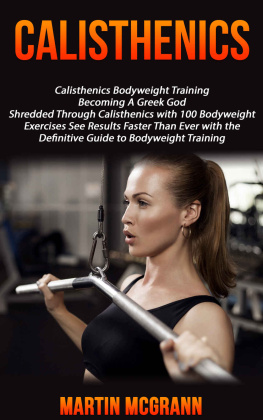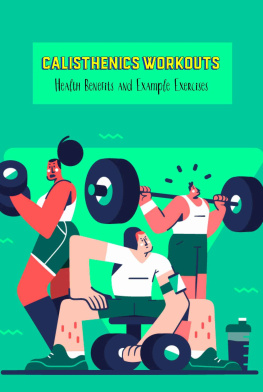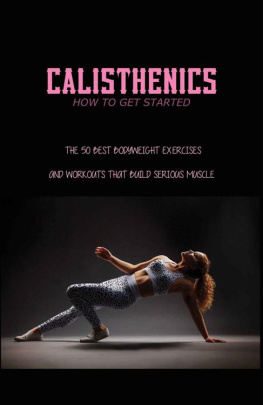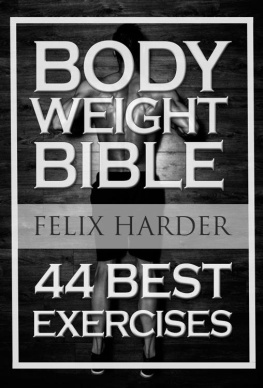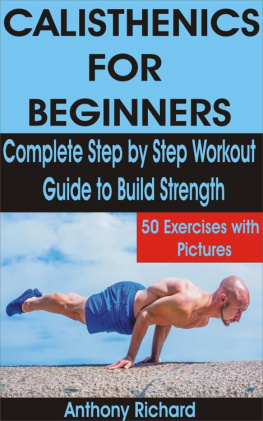The Ultimate Step-By-Step Calisthenics Workout Guide with 100+ Bodyweight Exercises to Strengthen and Increase Your Body Flexibility.
AN OVERVIEW
Calisthenics is an exercise that involves moving the body freely with different levels of rhythm and energy. The training covers such activities as jumping, stretching, swinging, bending, twisting, and kicking together with such movements as push-ups, chin-ups, sit-ups, and pull-ups. Calisthenics uplifts endurance, muscle strength, flexibility, coordination, and general body well-being, through regular and controlled pressures on the cardiovascular system. There are eight working principles I have penned down to help those who wish to develop specific skills in calisthenics and are: 1. Start with the basics, 2. You are working on your previous progression, 3. Have a good rest, 4. Reduce reps and increase sets; 5. Film yourself as you go on training, 6. Get a training partner, 7. Always exercise patients, and finally, 8. Be consistent.
The real benefits of calisthenics, as highlighted in this manual, will improve muscle strength, endurance, and flexibility. It contains a great comparison between calisthenics (bodyweight training) and weight lifting (weight training). As stated in this practical guide, calisthenics such as push-ups is more than just a beginners workout. Weight training, such as weight lifting, is the main deal in terms of training your strength. Calisthenics is primarily considered a vital activity, especially for beginners who are not yet ready for heavyweights. A standard view of these two concepts is that weight training is for muscular strength, while bodyweight training is for muscular endurance, or for preparing towards more tasking sports such as boxing or martial arts. It is a widespread view, especially for those hoping to engage in calisthenics exercise as beginners to compare it with other forms of activities they are already familiar with. Marjory, experiencing the difficulty in calisthenics against weight training as one of the most popular exercise methods worldwide, will aid you in making the right choice on which of them to choose. Fellow instructors in calisthenics and I have given so much advice on sets and reps, which I summarized thus: For muscle strength and endurance, take 1-5 repetitions for each set while for muscle mass, take 6-10 repetitions for each set.
As a beginner in calisthenics, you need to be armed to the tooth on the tips and tricks to erase all fears from your mind. Once you have done that, it will sound all interesting when you hear the name calisthenics exercise. Looking at the nutritional guide to lose weight and gain muscles at a glance, we considered 1. You are controlling your total calorie intake, 2. and observing regular or periodic fasting, 3. You are mindful of your nutritional and calorie density, among others. The following are the essential warming up exercises in calisthenics: running around, swinging of arms, scapula pulses, swing scapula, dismantling your shoulder, pulling bands apart, forming circles with wrist, open hand palm, stretched wrist, among others. Before going into calisthenics exercise in full, there are some preparations you need to put in place to avoid distractions during the training proper, which comprises but not limited to: taking care of your bills, engaging in some me essential calisthenics practice, taking a lot of water, consuming proper nutrition, packing your loads based on needs, among others.
There are about 18 practical core lessons in calisthenics with photos as stated in this book which are: handstring stand stretch, pirifomis stretch, lunge with a spinal twist, triceps stretch, shape 4 stretch, 90 @ 90C stretch, frog stretch, butterfly stretch, shoulder seated squeeze, side bend stretch, lunging hip flexor stretch, seated neck release, pectoral stretch while lying, knees to chest stretch, reclining bound angle pose, lying quad stretch, extended puppy pose, and standing quad stretch.
There are about 70+bodyweight exercises with Photos you can learn that were treated under three sub-headings viz: Upper Body, Core, and lower body, respectively. Also treated here are 6-weeks workout program to blast body fat. Losing body fat and getting shredded within a short period is not an easy task to accomplish. It would help if you had the support of an instructor or experts guide in calisthenics to keep you in the right direction. Getting enough quality sleep per day for yourself can be a catalyst to quick recovery between workouts; observing 6-8 hours of sleep a night will be sufficient. And finally, there are two levels of focus in calisthenics, mostly for beginners: beginner level and intermediate levels. But before getting to intermediate levels, you need to master the beginner levels first; that is why you are required to go through the transition from one level to the other in a progressive manner, as stated in this book. Owing this workout guide is already 60% complete in attaining your dream body shape or get reaped with Calisthenics exercise while the 40% requires your implementation beginning from the first chapter to the last.
CHAPTER ONE: AN INTRODUCTION TO CALISTHENICS EXERCISE
Calisthenics is an exercise that involves moving the body freely with different levels of rhythm and energy. The training doesn't require wearing things like wands and rings. The exercise covers such activities as jumping, stretching, swinging, bending, twisting, and kicking coupled with such movements as push-ups, chin-ups, and sit-ups. Calisthenics uplifts endurance, muscle strength, flexibility, coordination, and general body well-being, through regular and controllable pressures on the cardiovascular system. Calisthenics can serve as preamble exercises for other, more challenging sports and can also help to build body physique.
As advocated by Beecher, calisthenics was initially intended to be an exercise for ladies, but it soon gained popularity and was later embraced by both sexes. The exercise began in the early 19th century based on Friedrich Ludwing Jahn, a German and Aldof Spiess in doing gymnastics well known worldwide. Catherine Beecher from the United States of America wrote on Calisthenics and Physiology for secondary schools and families to promote calisthenics exercise in the year 1857. Primary and Secondary Schools both became beneficiaries of calisthenics all over the western world as a regular exercise in the 20th century. It was at this time that the health benefits from calisthenics were given international recognition. More so, the military base adopted it as part of its training manual.
CHAPTER TWO: THE 8 WORKING PRINCIPLES OF CALISTHENICS
The first time I thought about the workout was during my young age, all I thought of was how to develop muscular strength resembling those of the great wrestlers. I was doing some exercises that look precisely like calisthenics, but they are less severe, for example, the raised straight legs hitting the bar, I engaged in it very well; little do I know that in the future, it will turn out to be a real exercise. At my age then muscle-up and the squat was a common exercise among my peers. As the years go by, these exercises that we took very common then have been developed into a full-grown worldwide exercise called calisthenics. It emphasizes training people to learn bodyweight skills; gaining muscle strength through this process is not the primary purpose of the movement.
If your so aim of engaging in this type of exercise is to obtain a skill at the end and not merely for muscle and fun, then you must abide by these eight principles I have laid down for you:
1. START WITH THE BASICS
The working principle of life states that you should sit before crawling, craw before standing, stand before walking, and so on. Starting with pull-ups before venturing into a muscle-up, it will be unwise and uncalled-for if you are not yet good at basic calisthenics and you aim at more advanced calisthenics exercise, the right to make if you really want to acquire those skills you want in calisthenics exercise, have a better foundation around basic calisthenics. Target exercises like; push-ups, wall sits, squats and hanging knee raises before you think of something tougher. Skills at an advanced level are developed based on consistency in the most important exercises.


